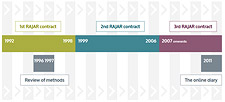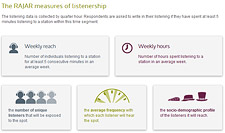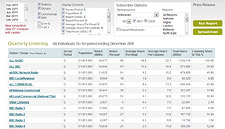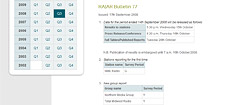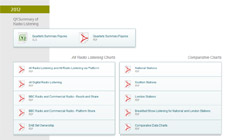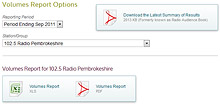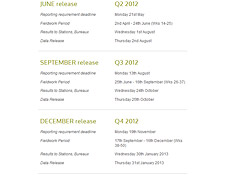Fieldwork materials
Questionnaires
At each household a Recruitment Questionnaire is first administered to check for any potential conflicts (e.g. if the respondent is a station employee), quota eligibility and to select an adult (15+) with whom to place a diary.
Demographic details of the selected adult and their household are also recorded, together with other information including the number of radio sets and car radios owned.
The questionnaire also includes a DAB, Television and Internet section. Respondents are asked whether they know about DAB radio and if they own a set, whether they have access to digital TV and/or the internet and if they listen to the radio using these platforms.
Station Cards and Labels
The interviewer conducts a procedure in which each respondent is asked to sort through a set of cards with the names of radio stations available in the area. Each respondent is asked to select:
- stations they listened to or heard in the last year.
- stations they have heard elsewhere or chosen by somebody else.
This produces a listing of each respondent’s repertoire of radio stations. The interviewer then sticks the labels for these stations into the diary along a fold-out flap which, when unfolded, lines up the labels with the tops of columns on the diary listening pages.
The Diary
The diary is divided into two distinct sections. The first section is a self-completion questionnaire which covers media consumption including radio stations awareness, television viewing, newspaper readership, Internet and mobile phone/tablet listening, apps, business influence and social media. The second section is the radio listening diary.
The radio listening section covers the period from Monday to Sunday, with two pages given to each day. The day is divided into quarter-hour time segments from 6am to 12 midnight, with 12 midnight to 6am being divided into half-hour segments. Each day starts at 4am. These time segments are listed down the side of each page whilst labels for the radio stations chosen by the card sort procedure (above) appear on the fold-out flap across the top.
For any occasion when they listen to the radio for 5 minutes or more, respondents are asked to record their listening by drawing a line through the time segment boxes relevant to the "station listened to" and the time when listened. A corresponding line is drawn through one of the "where listened" columns to indicate whether the listening took place "at home", "in a car, van, lorry" or "at work / elsewhere". If no listening has taken place during any half-day period, the "I did not listen to the radio at any time during this period" box must be marked to indicate this. Thus the respondent is encouraged to use the diary on a daily basis.
From Q1 2007, the diary additionally features 4 platform columns (AM/FM, DAB, DTV, Internet), thus allowing each station to identify its listening by platform.
The interviewer leaves the station label sheet with unselected station labels and respondents are encouraged to stick in the labels themselves for any station they might hear which they did not select during the card sort procedure (above). They may also write in the names of any services without labels to which they have listened.
Full names, frequencies and brief descriptions of programme content for each listed radio service are provided in the diary.
It is emphasised to light and non-listeners that their co-operation is still vital as the survey has to give a fair representation of the whole population, not just radio listeners. Also, even if they do not listen at all during the survey week, their television viewing and newspaper readership information is important in itself.
The back cover of the diary is given over to respondents to write in any comments they may wish to make on the stations and programmes that they listen to. This information is then fed back to the station it relates to.
Incentives
All individuals taking part in the survey are given a pen. In addition, there is a monthly prize draw for all respondents who return their diaries. This is detailed in the respondent letter. Separate prize draws are operated for 10-14 and 15-24 year-olds and 25-34 year-old men; these are detailed on leaflets given to respondents in these sub-groups.


